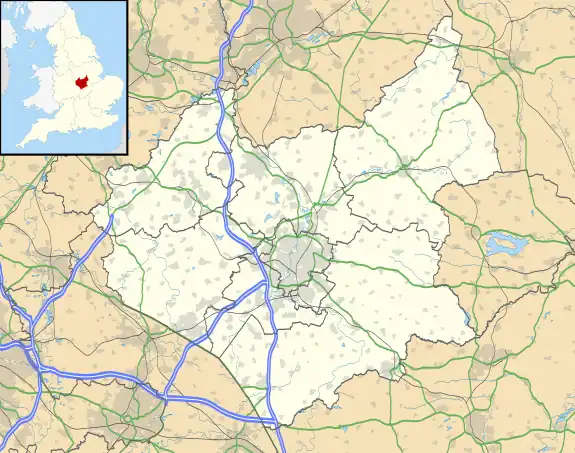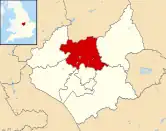Seagrave
Seagrave is a village and civil parish in the Charnwood district of Leicestershire, England. It has a population of around 500, measured at the 2011 census as 546,[1] It is north of Sileby and close to Thrussington and Barrow upon Soar.
| Seagrave | |
|---|---|
 The Village Sign | |
 Seagrave Location within Leicestershire | |
| Population | 546 |
| District | |
| Shire county | |
| Region | |
| Country | England |
| Sovereign state | United Kingdom |
| Post town | LOUGHBOROUGH |
| Postcode district | LE12 |
| Dialling code | 01509 |
| Police | Leicestershire |
| Fire | Leicestershire |
| Ambulance | East Midlands |
| UK Parliament | |
History
One of the earliest mentions of this place is in the Domesday book where named Segrave,[2][3] it is listed amongst the lands in the wapentake of Goscote given to Henry de Ferrers[4] by King William I. The land consisted of work for one plough and four acres of meadow.
By the twelfth century, Seagrave was owned by the de Segrave family, who built a fortified manor house in the parish.[5] Their familial coat of arms was later adopted by the village. In March 1234, Richard Siward, at the head of a company of outlaws, ravaged Stephen de Segrave's native place, evidently Seagrave; burnt his fine houses, oxen, and stores of grain, and carried off many valuable horses and rich spoil. Later, the same band ravaged Alconbury, and burnt his buildings there.[6] In 1346, population growth led to the division of the wapentake; for judicial matters, Seagrave was in the hundred of East Goscote.
The effects of Parliamentary enclosure on social and economic aspects of England and its people can be understood by examining the results of the Seagrave enclosure act of 1760, which effectively converted copyhold tenure in the open fields to freehold tenure.
The village attempts to preserve its better buildings through repurposing.[5] The Primitive Methodist chapel was converted into a house which still has the original nameplate, with Primitive spelled in an obsolete form as 'Primative'.
Leicester City F.C. opened a new state of the art training facility on the site of the village's former Park Hill Golf Club in December 2020.[7]
Gallery
 Berrycott Lane joins King Street at the Eastern end of the village.
Berrycott Lane joins King Street at the Eastern end of the village. Looking east from Green Lane towards King Street.
Looking east from Green Lane towards King Street. King Street
King Street King Street
King Street Green Lane
Green Lane All Saints Church
All Saints Church
Notable people
Gilbert de Segrave of Segrave, High Sheriff of Warwickshire and Leicestershire in 1193, father of Stephen de Segrave (c. 1171 – 1241) Chief Justiciar of England.
Robert Burton, author of The Anatomy of Melancholy, was rector of All Saints' Church in Seagrave from 1630 to his death.
References
- "Civil Parish population 2011". Neighbourhood Statistics. Office for National Statistics. Retrieved 20 June 2016.
- "Domesday Book of William the Conqueror". DomesdayMap.co.uk. Domesday Map. Retrieved 15 March 2020.
- "32434 Domesday Book place-name forms alphabetic order" (PDF). KeithBriggs.info. Keith Briggs. 2014. Retrieved 15 March 2020.
- Williams & Haward Martin 2003, pp. 656–7
- "Seagrave and its background" (PDF). Seagrave.LeicestershireParishCouncils.org. Seagrave Parish Council. 28 January 2015.
- Hunt, William. "Segrave Stephen de (d.1241)" – via Wikisource.
- "Leicester City make historic move to new Seagrave training ground". www.LCFC.com. Leicester City Football Club. 22 December 2020. Retrieved 19 January 2021.
Bibliography
Williams, Ann; Haward Martin, Geoffrey (2003), Domesday Book: A Complete Translation, Penguin, ISBN 0-14-143994-7
